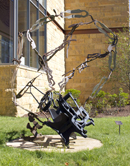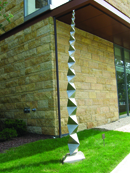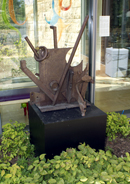
William Kent (b. 1919)
Mangabey, 1955
MarbleFriends Purchase Fund, 1974.92 Self-taught graphic artist and sculptor William Kent originally studied music at Northwestern University and Yale University prior to focusing on printmaking and, subsequently, sculpture. Throughout the 1960s he was aligned loosely with the Pop Art Movement when he created political prints depicting the tumultuous decade. In 1977, Kent began to work exclusively as a sculptor. A Mangabey is a genus of endangered monkeys found only in Africa. There are nine species of Mangabey that live in Sierra Leone, Nigeria, Zaire, Kenya and Tanzania. They are communicative, loud creatures who are unique among monkeys because they use their faces to express their emotions. Kent’s Mangabey, despite appearing mischievous, happily welcomes visitors to the Museum.
(click to close)

Tom Doyle (b. 1928)
Lunasa, 2006
Oak and cherry This project has been supported by a grant from the Artist’s Resource Trust and Charles F. Smith Fund, 2006.124 Tom Doyle became interested in sculpture after working in a blacksmith’s shop and taking a mechanical arts class in high school. Doyle draws his inspiration from varied sources, including the calligraphic gestures of Abstract Expressionism and nineteenth-century bridge building. He aims to uncover methods of defying gravity and space by attempting to make heavy objects appear weightless and float without obvious support. Built to human scale, Lunasa creates an interactive space that the viewer is encouraged not just to view but also to experience by walking toward, through, and around it. Lunasa manages to achieve a simplistic beauty while retaining a certain tension as it strains and bends skyward yet remains grounded, both straining to break and adhering to the laws of nature. This wooden sculpture is named after an ancient Celtic harvest festival (Lughnasadh) that honored the Irish god Lugh, patron of the arts. To this day, the Irish celebrate this holiday with bonfires and dancing. The Christian Church has established the tradition of blessing the fields on Lughnasadh in hopes of a prosperous year of harvest. Standing between the Museum and the fields of Walnut Hill Park, Lunasa celebrates the beauty of both nature and art.
(click to close)

Nancy Graves (1939-1995)
Indicate, 1982
Cast Iron and Cor-ten Steel Stephen B. Lawrence Fund, 2010.54 A sculptor, painter, printmaker, and occasional filmmaker, Nancy Graves was known for her focus on nature. Her personal aesthetic emerged from a combination of childhood memories and the concepts of Abstract Expressionism prevalent in her formative years. Her works represent an interchange between the replication of nature and the formal values of abstract art. Graves’ interest in nature spurred her to combine both natural and man-made elements within her artworks. The machine which serves as the base of Indicate is actually an offset lithography press. Many of the additional elements are bits of hardware which are especially relevant to New Britain, long identified as the hardware capital of the world. This use of industrial products to create sweeping, organic forms demonstrates Graves’ ability to synthesize the dueling forces of industry and nature.
(click to close)

Nathaniel Kaz (b. 1917)
Don Quixote, ca. 1941
Bronze Gift of Rolf Liebergesell, 2007.68 A child prodigy, Nathaniel Kaz began his career in Samuel Cashwan’s (1900-1988) studio when he was only nine years old. He became a professional sculptor by the age of 17 after attending The Arts Students League of New York. Kaz’s award-winning work is in the permanent collections of the most preeminent museums in America, including the Museum of Modern Art and the Metropolitan Museum of Art. This bronze statue represents Don Quixote, Miguel Cervantes’ hero from the novel bearing the same name. He stands stiffly at attention as if on the lookout for imaginary damsels to rescue or giants to attack. The comical bend of his sword and his absurdly elongated head accentuate the amusingly delusional qualities that characterize the “Man of La Mancha.”
(click to close)

Howard Fromson (b. 1921)
Tetra Tower, 2005
Stainless steel Gift of the artist, 2006.30 Howard Fromson’s creations defy simple categorization as art since his interest in functional objects is an integral part of his creative process. Fromson is an inventor with over 100 patents in various fields and begins his artworks with simple geometric forms, regardless of function. Fromson’s Tetra Tower, a tapering and delicate spire of mirrored equilateral triangles, seems to teeter on the edge of solidity. It plays with the viewers’ perception as the strength suggested by the material is coupled with a nervous fragility suggested by the precariously stacked forms.
(click to close)

Marianna Pineda (1925-1996)
Prelude, 1957
Bronze Gift of the artist’s family, 2003.07 Marianna Pineda was a twentieth-century American sculptor whose preferred media were bronze, wood, stone, ivory and wax. From these materials she repeatedly shaped female figures which explored the essential themes of existence as both a human being and a woman. These included creativity, family and the various stages of life. Prelude is a bronze sculpture of a woman in labor. This scene is not defined by the presence of either midwife or infant; rather, it is implied by Pineda’s repetition of “X” shapes. The entire figure creates one elongated “X,” stretching between the woman’s elbows and knees. This shape also features in the fabric of the skirt and in the tie of that skirt, which the woman has wrapped around her hands and stretched out beneath her torso. These “X’s” create visual conflict, illustrating the woman’s personal and physical struggle with the forthcoming birth of her child.
(click to close)

Alexander Archipenko (1887-1964)
Prelude, 1957
Bronze (posthumous cast) Frances Archipenko Gray Collection, 2007.118LTL As an active sculptor throughout the Cubist Movement, Alexander Archipenko used negative space to change the way one looks at the human figure. In doing so, he explored the concave/convex, solid/void relationship in an array of permutations, and throughout his career he was renowned for incorporating mixed genres in his innovative work. The Biblical story of the Queen of Sheba’s visit to King Solomon continues to inspire countless artists. In Queen of Sheba Archipenko explores the radical notion of displacing heads or torsos in the human figure and leaving a void in its place. This bronze Queen makes use of organic contours to suggest a human form, distinctly female in its elegant curvature. Exhibiting an intriguing play of positive and negative space, as well as smooth and textured surfaces, Queen of Sheba gives a sense of skewed symmetry as well as striking composition.
(click to close)

Alexander Liberman (1912-1999)
Untitled, ca. 1964
Corten steel Gift of Francine DuPlessix Gray, 2005.201 Russian-born artist Alexander Liberman lived in Moscow, London and Paris before emigrating to New York City in 1941 and beginning a successful career in magazine publishing. Hired first by Vogue Magazine, twenty years later he became Editorial Director for all of Conde Nast Publications, a position he held until his retirement in 1994. Liberman also had a successful career in art after taking up painting and later, sculpture. He is most recognized for his large-scale, abstract sculptures made using industrial materials, which resulted from the artist’s fascination with the industrial culture of America. Because of these parallel careers, Liberman is credited with forging a relationship between avant-garde art and fashion after commissioning such artists as Salvador Dalí (1904-1989) and Marcel Duchamp (1887-1968) to contribute to Vogue projects. An early work, Untitled is much smaller in scale than the monumental sculptures for which Liberman is best known. It consists of a haphazard collection of shapes made out of steel that have been manipulated and assembled by the artist, so that their original incarnations are no longer evident. Several long, tubular forms jut out from the main core of the sculpture, invading the space of the viewer. The monochromatic coloring and the severe, almost precarious appearance are typical of Liberman’s sculptural aesthetic. Untitled was donated by Francine DuPlessix Gray, the renowned author. Her mother Tatiana was married to Liberman.
(click to close)

Martin Kline (b. 1961)
Painting Sculpture, 1999-2009
Bronze Long term loan from the artist, 2012.04 LTL Inspired by the human interaction with nature, both physical and philosophical, Martin Kline is best known for creating mesmerizing encaustic works that take the viewer on a journey through color, pattern and texture. His paintings and sculptures also thoughtfully engage with a wealth of art historical and cultural knowledge, adding multiple layers of meaning to conjure what has been called the “anti-icon . . . involving the mind in the perception of a work of art that is gradually rather than instantaneously grasped.” Kline builds upon the tradition of encaustic painting, which has been longstanding in many cultures around the globe. The process involves combining wax with color pigment and manipulating the medium into an endless array of forms. As his surfaces became more and more built-up with layers of wax, he concluded that his paintings would simultaneously become sculptures – a duality perfectly captured in Painting Sculpture. Consisting of a painting that has been cast in bronze, Painting Sculpture represents a transformation of the ephemeral into the permanent – a monument to the act of making art itself. Furthermore, it taps into the tradition of trompe l’oeil (French for “fool the eye”), an art technique that aims to produce optical illusions. Indeed, at first glance the surface of the work appears painted and its easel wooden – an effect that is debunked only upon a second, closer look.
(click to close)

Arthur Carter (b. 1931)
Intersecting Ellipses with Parallel Chords, 2003
Stainless Steel Gift of the Artist, 2010.03 Arthur Carter pursued several highly successful careers as an investment banker, entrepreneur, and founder/publisher of two newspapers before becoming a fulltime sculptor in 1990. His work is inspired by modernist artists, such as Pablo Picasso (1881-1973) and Alexander Calder (1898-1976). Carter’s works reflect a love of geometry and music as well as an admiration for the elimination of excessive details. His pure and powerful sculptures take on lives of their own as they appear to have suddenly sprung from the ground to actively interact with the viewer. Intersecting Ellipses with Parallel Chords launches a multi-dimensional labyrinth of considerable complexity. From the simple and open interplay of one or two arcs and chords, the intricate sculpture depends on strict, isomorphic discipline to retain its essential unity. This gravity-defying artwork seems to explode and contract in unison. The outer ring holds in the fragmented circles that expand into squares and triangles while, at the same time, forces them back to unity as a circle.
(click to close)

Caroline Lee (b. 1932)
The Evangelist, 1980
Stainless steel Gift of Dr. Samuel Johnson, Dr. Theodore Johnson, and Mrs. Patricia Johnson Andrews. Given in memory of their parents, Mrs. Anne Bingham Johnson and Herbert E. Johnson, 1980.17 Caroline Lee earned a B.A. from the University of Chicago and a B.F.A. in painting and drawing from the Art Institute of Chicago. In the 1950s, she apprenticed at the Fonderie André Susse and the Oxhydrique Française in Paris, France. Lee has exhibited her work extensively throughout Europe and, in 2007, she participated in the first Biennial of Sculpture in Yerres, France. The Evangelist is composed of cold, stainless steel and is characterized by hard-edged, jutting appendages. Its design is appropriate to our time in which space age robots have become substitutes for human beings in many places, and this sculpture even has the vague suggestion of a human form. However, the sculpture might also suggest a crucifix, as the four Evangelists each authored a gospel in the New Testament describing the death of Christ.
(click to close)

Seymour Lipton (1903-1986)
Thorn Mill, 1975
Bronze on monel metal Gift of Barbara Palmer, 2007.123 Interestingly, Seymour Lipton was initially trained as a dentist, but in 1932 switched his focus towards sculpture. Throughout the 1930s and 40s, Lipton worked largely in wood, carving figures in the Social Realist style. A visible shift can be seen in his work with the start of World War II as he began to explore darker themes and increasingly referenced war in his works. Consequently, he turned to metal as a more suitable means of exploring the feelings of disillusionment and distress brought on by the atrocities that had become a part of daily life. Thorn Mill is exemplary of the avant-garde approach of Lipton’s more mature works. This sculpture suggests the surrealist practice of automatism, a technique used to express the creative force of the unconscious in art. Like the Abstract Expressionist painters, Lipton turned his back on traditional forms of representation. The result is an arbitrary arrangement of abstract forms that parallels the gestural painting of the Abstract Expressionists in the 1940s and 50s.
(click to close)

Sol LeWitt (1928-2007)
Complex Form #4, 1987
Painted aluminum Gift of the artist and Members Purchase Fund, 1995.25 Rising to fame in the late 1960s, New Britain native Sol LeWitt emerged as an influential figure in modern art and contributed directly to the development of major art movements such as Minimalism and Conceptualism. LeWitt’s frequent use of open modular structures originates from the geometric form of the cube, an inspirational and prominent feature of his work throughout his career. Complex Form #4 illustrates the style of LeWitt’s later work in which he emphasized the monumentality of the idea and its manifestation. He continued to use lines, grids, and geometric systems. The stark whiteness of Complex Form #4 calls to mind a crystal. This is a fitting reference considering the geometric and structural patterns occurring on both the micro and macro levels of crystalline structures. This sculpture tests the viewers’ perceptual flexibility, asking for openness in both visual and psychological reception.
(click to close)

Elbert Weinberg (1928-1991)
The Blind Sister of Narcissus, 1989
Bronze Acquired from the Elbert Weinberg Trust, 2011.75 Hartford-born sculptor Elbert Weinberg is best know for his figurative, lyrical works. Captivated by the arts since a very young age, Weinberg enrolled at the Hartford Art School when he was fourteen and continued his studies at the Rhode Island School of Design and later at the Yale School of Design. He went on to become the youngest recipient the Prix de Rome, which entitled him to two years of study in Italy. He revisited Rome again in 1959 through the Guggenheim Fellowship. After his return to the United States in 1970, Weinberg embarked upon his career teaching sculpture, joining various institutions such as Boston University, Yale University, and Union College. The Blind Sister of Narcissus exemplifies Weinberg’s interest in mythological motifs. As the title of the sculpture suggests, the female nude is the sister of Narcissus, a Greek god who fell in love with his own reflection in a pond, only to die and have the flower Narcissus grow in his place near the banks. With her arms and legs pulled tightly inward into a contorted self-embrace, she exudes the same blind self-love that brought Narcissus to his demise. Lacking any outward gesture to share the love so clearly expressed in her face, her sculpted form appears closed in. In creating this delicately balanced, yet completely self-contained sculpture, Weinberg demonstrates the all-consuming, isolating effects of narcissism.
(click to close)

Chaim Gross (1904-1991)
Tightrope Acrobats, 1962
Bronze On loan from the Renee and Chaim Gross Foundation Born in Austria, Chaim Gross came to the United States in 1921 to pursue his lifelong dream of becoming an artist. He studied sculpture at the Educational Alliance Art School from 1921-1927 in New York City and received a strong classical education. There he studied with Ben Shahn (1898-1969) and Adolph Gottlieb (1903-1974). Over time he turned away from the classical forms of sculpture and adopted a more abstract style. Movement was always an important factor in Gross’s sculpture, and he consistently emphasized expressive bodily gestures and abstract lines and curves. In Tightrope Acrobats, Gross suspends in perfect equilibrium three figures in the middle of a routine. Their bodies span upwards and outwards, simultaneously creating one dynamic entity. Tightrope Acrobats is made of bronze, a medium Gross favored later in his career because of the freedom that preceding plaster casts allowed him. The surface of the bronze is covered in a rich natural texture further animates the work. Gross used an abstract style emphasizing forms and volume to articulate a playful, spirited language of movement and rhythm. Whatever his choice of medium, Gross’s sculptures contain a compelling sense of life and vitality, unique to sculpture at the time.
(click to close)

Carol Kreeger Davidson (b. 1932)
Sacella, 1999
Aluminum and stained glass Gift of the artist, 2000.85 Carol Kreeger Davidson has achieved critical acclaim for her eccentric and imaginative sculptures. Her work is primarily focused on modern depictions of ancient myths in abstract forms. Her inspiration is derived from an interest in human secrets and the tensions between interior space and outer surface. Davidson predominantly works with bronze and aluminum. A “sacellum” is a chapel or altar similar to those used by ancient Romans for devotion. Appropriately, Sacella provides a modern space for meditation and taps into the intrinsic human need for contemplation and memorial.
(click to close)
